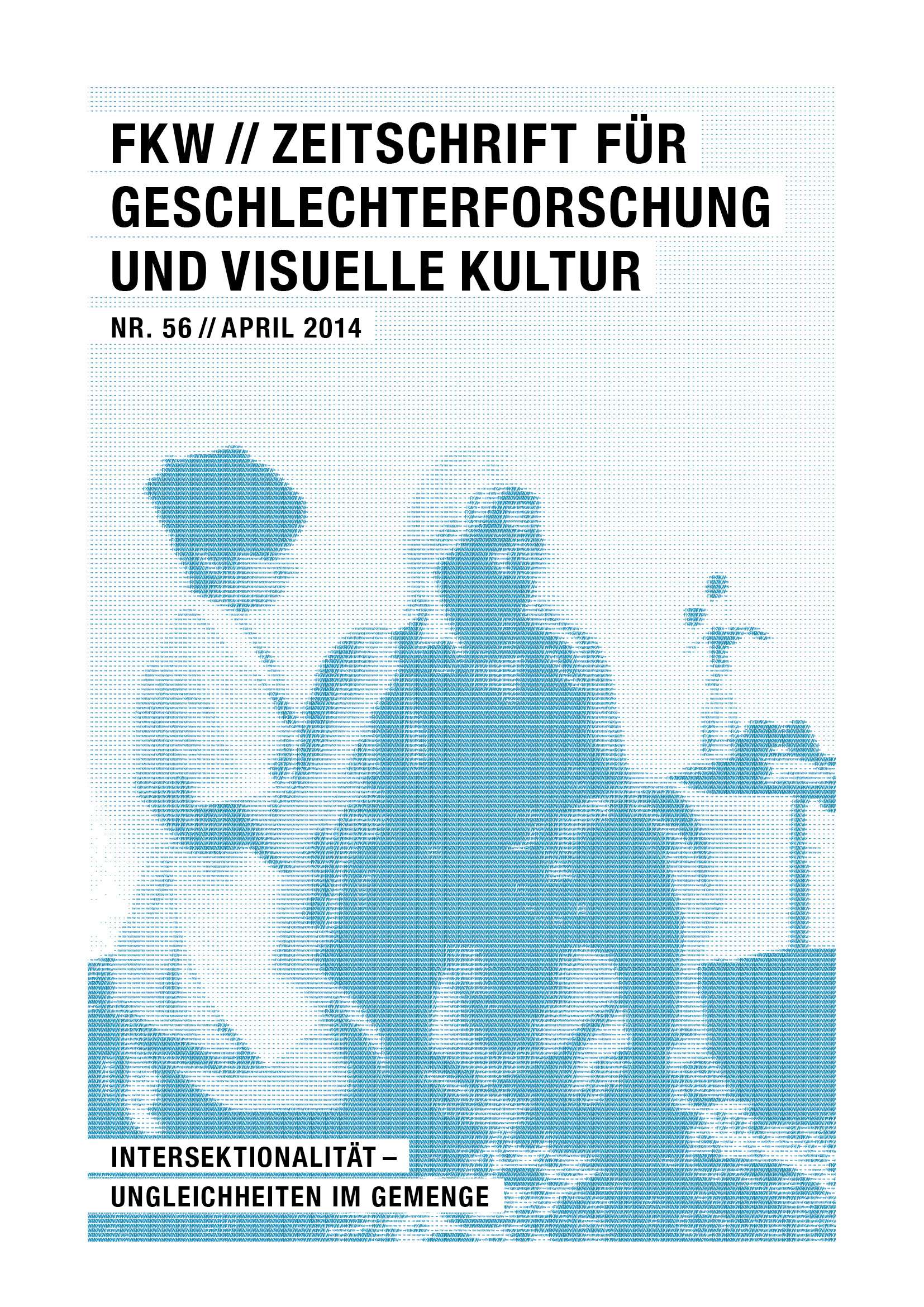Two Blue Crocodiles [...] Theorie_Praxis - Eine Frage der Verkehrsregelung?
DOI:
https://doi.org/10.57871/fkw5620141286Abstract
By reference to Mart Busche's and Olaf Stuve's animated Video Clip “Two Blue Crocodiles and the Gap in the System”, designed as an „educational film“ for further education and prevention of violence in order to “‘introduce’ the concept of intersectionality” (Busche/Stuve 2012) the article interlinks the following issues: Discussing the Video Clip as an audio-visual format conceptualized to communicate intersectionality, and its perception by experts from the field of education and training, it analyses the role of visual representation in this context, as well as the preconditions of perception, and the relation between intersectionality and Visual Culture. Further, a rereading of Kimberlé Crenshaw's metaphor of “intersection” introduced in 1989 in her article “Demarginalizing the Intersection of Race and Sex” – which had a lasting effect until today not only by coining a term but also in shaping a notion – prompts focussing on the concept of responsibility. Interlinking the questions of responsibility, the critique of representation, the relation of theory and practice, and the consequences to draw for an anti-discriminatory theory_practice, the article with respect to aspirations to challenge hegemonic constructions of reality – and contrary to popular juxtapositions of theory and practice – argues for an understanding of theory_practice fully aware of its responsibility.
Der als „Lehrfilm“ für eine „‚Einführung‘ in das Intersektionalitätskonzept“ in der Erwachsenenbildung und Gewaltprävention konzipierte animierte Videoclip Zwei blaue Krokodile und die Lücke im System (Busche/Stuve 2012) bildet den Ausgangspunkt für die Analyse und Verknüpfung folgender Fragenkomplexe: Zum einen werden ausgehend von der Analyse dieses Videos als audiovisuelles Format zur Vermittlung von Intersektionalität sowie dessen Rezeption im Bildungs-/Beratungsbereich kritische Überlegungen zur Rolle visueller Repräsentation in diesem Kontext, den Voraussetzungen von Wahrnehmung und zum Verhältnis der Konzepte von Intersektionalität und von Visueller Kultur entwickelt. Zum anderen wird über eine Relektüre von Kimberlé Crenshaws – in ihrem begriffsprägenden Aufsatz Demarginalizing the Intersection of Race and Sex 1989 formulierter – Metapher der Straßenkreuzung, die ein bis heute nachhaltig wirksames Vorstellungsbild generierte, der Fokus auf den Begriff der Verantwortung gerichtet. Die Fragen der Verantwortung, der Repräsentationskritik, des Verhältnisses von Theorie und Praxis und der Konsequenzen für eine antidiskriminatorische Theorie_Praxis miteinander verknüpfend, wird, entgegen gängigen Gegenüberstellungen von Theorie und Praxis, in Hinblick auf kritische Interventionen in hegemoniale Realitätskonstruktionen für eine verantwortungs-bewusste Konzeption von Theorie_Praxis argumentiert.
Downloads
Ausgabe
Rubrik
Lizenz
Die Autor_innen behalten das Copyright und treten keine exklusiven Nutzungsrechte an FKW ab.
Ab 2017 erscheinen alle Texte von FKW // Zeitschrift für Geschlechterforschung und visuelle Kultur unter der LizenzCC-BY-NC-ND Lizenz 4.0 International (Creative Commons, Namensnennung, Nicht Kommerziell, Keine Bearbeitung 4.0 International). Der Lizenzvertrag ist abrufbar unter: https://creativecommons.org/licenses/by-nc-nd/4.0/legalcode.de, eine allgemein verständliche Fassung unter: https://creativecommons.org/licenses/by-nc-nd/4.0/deed.de
Von 2013 bis 2016 sind alle Texte von FKW // Zeitschrift für Geschlechterforschung und visuelle Kultur unter der Digital Peer Publishing Lizenz (DPPL) erschienen. Der Lizenztext ist im Internet abrufbar unter der Adresse: http://nbn-resolving.de/urn:nbn:de:0009-dppl-v2-de3
Die Abbildungen in Ihrem Beitrag
Die Autor_innen verpflichten sich, die Abdruckgenehmigung für die in ihren Texten verwendeten Bilder bei der jeweiligen, die Bildrechte verwaltenden Institution einzuholen und die zuständige Herausgeberin über das Ergebnis zu informieren. Wir weisen darauf hin, dass die Verwendung von Bildern in wissenschaftlichen Texten gewöhnlich als Zitat angesehen und entsprechend kostenfrei gewährt wird.





